Shango: The Orisha King of Fire and Lightning
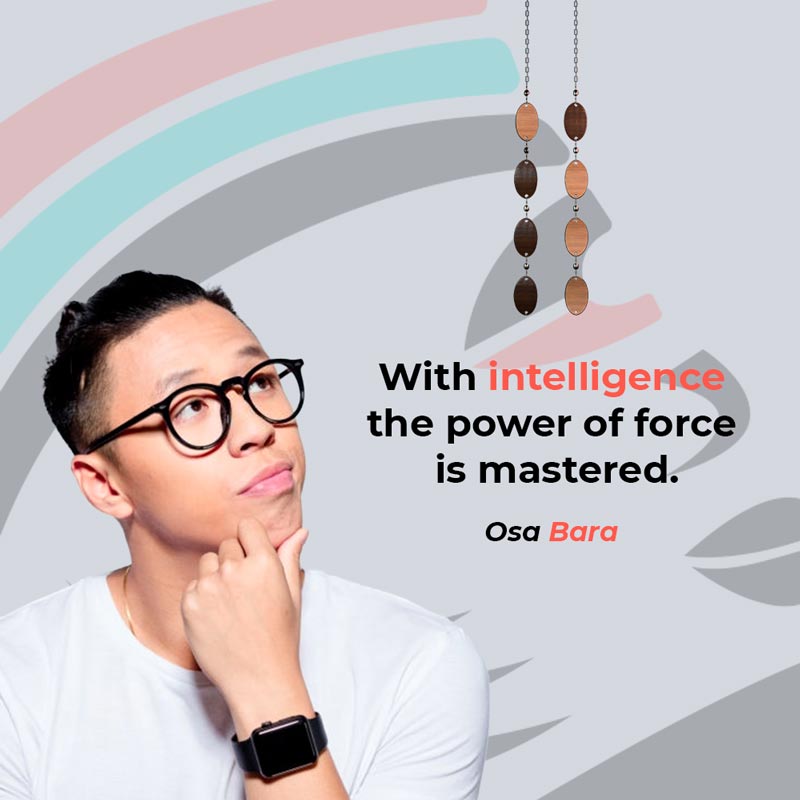
Shango, also known as Chango, stands out in the Yoruba religion and Santería as the supreme deity of thunder, fire and lightning. Beyond his mastery over the elements, this Orisha is revered as a master military strategist, whose introduction of cavalry revolutionized combat tactics and allowed the expansion of his kingdom. His legacy extends through numerous battle victories, cementing his status not only as a legendary warrior, but also as a revered divine protector.
Who is Shango?
Shango, the fourth king of the Oyo empire in Nigeria, is perhaps the most revered and well-known Orisha in the Yoruba pantheon.. His arrival into the world was not ordinary; It is said that he descended from the sky engulfed in flames, marking his birth with roars of thunder that announced the arrival of a being of incomparable power. This celestial event is the basis of his association with thunder and lightning, elements that he uses to manifest his will and power.
Endowed with exceptional virility and physical perfection, Shango is an icon of masculinity, male fertility and war. His wisdom in the secrets of men is immeasurable, granting him a place of honor on the natural throne of the royal palm. As the husband of the Orishas Oyá, Oba and Oshún, and lovingly related to Yewá, Shango is also a dedicated father to the Ibeyis, the divine twins, and is considered a son by Yemaya, reinforcing his position as a paternal and protective figure. .
His skill on the battlefield is legendary; It was he who taught his followers combat strategies, leading by example and using cavalry to expand his kingdom. This strategic mastery not only ensured his dominion over vast African lands but also cemented his reputation as an illuminator of all lands, known and revered by all.
The Many Names of the Orisha of Lightning and Fire

Across different cultures and regions, Shango is known by a variety of names, each reflecting an aspect of its complex nature:
- Shango, Chango: The most common names, widely used in the African diaspora.
- Olufin: It means "the owner of the secret" or "the revealer of the truth."
- Kabiosile: Royal greeting to Shango, which translates to "The king does not bow."
- Alaafin: This title, meaning "The owner of the palace," emphasizes his role as a divine leader and king.
- obakoso: Literally "The king is not dead", symbolizing his immortality and eternal presence.
- Elitimo: "The owner of knowledge and the bright eye", highlighting his wisdom.
- Afonjá: Honoring his legacy as King of Oyo land.
- Sango Ogigi: A popular nickname that underlines his mastery over thunder.
- oramfe: Name under which he is venerated in Ile Ife, the sacred site and central city of the Yoruba people.
- jakuta: "He who throws or fights with stones" reflects his warrior and protective aspect.
These names not only mark the veneration of Shango throughout Africa and beyond, but also underscore his multifaceted influence on justice, power, wisdom, and protection. As a central figure in the Yoruba pantheon, Shango continues to inspire his followers, offering them courage, protection, and spiritual guidance.
Shango and Justice
Shango's connection with justice is profound, evidenced in the Odu of Ifa Ogbe Bara. One story tells that, watching from heaven, he saw the corruption and evil that plagued the world. Determined to purify the land, he prepared for battle, unleashing a tornado that he leveled the houses of evildoers. However, upon realizing that one of the affected houses belonged to Ogbe Bara, his friend and benefactor, Shango stopped his anger. This act underlines the essence of this Orisha: although he is ruthless with the wicked, he is fair and merciful with those who deserve it.
The figure of Shango represents a beacon of hope and protection, reminding us of the power of justice, strength and wisdom. His legacy continues to inspire those who seek the courage to face their own battles, ensuring his place as an eternal deity in the hearts of his faithful.
Characteristics, Virtues and Powers of Shango
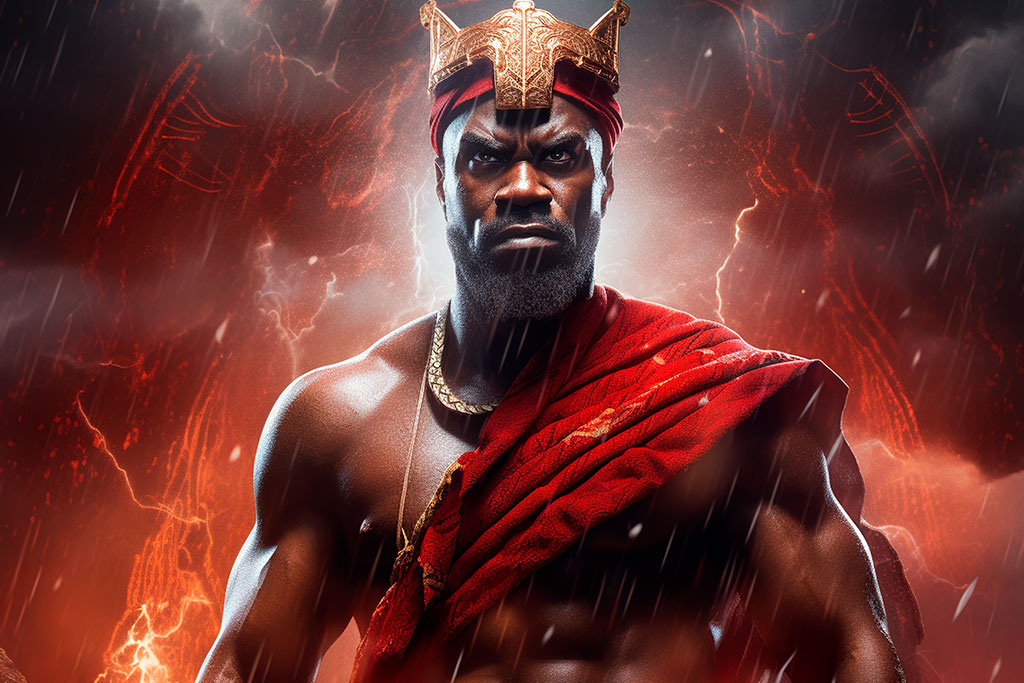
Shango, within the Yoruba or Santería religion, is a multi-faceted Orisha who embodies justice, power and vitality. Known for his energetic character and his passion for justice, is a relentless defender of the truth, punishing bandits and liars with his divine wrath. However, his presence is not limited to acts of retribution; He is also a being of deep joy, who celebrates life with dance and music, demonstrating his mastery in the art of Batá drums.
The Duality of Shango
Shango is an entity of contrasts: just as he can be fierce and fearsome in battle, he is also the soul of parties and celebrations. His love for dance and his exceptional skill as a dancer are legendary, a grace that resonates with the Odu of Ifa Oyekun Ogundá, who describes him as an incomparable dancer. This playful aspect of his personality makes him approachable and beloved among his devotees, balancing his fearsome presence with a lively and joyful spirit.
Spiritual Powers and Roles
Appointed by Olodumare as the spokesperson on the Divine Council, Shango plays a crucial role in the cosmic order, mediating between mortals and the divine. Every Saturday, when the council meets, Shangó assumes the responsibility of judging human actions, ensuring that justice and moral balance are maintained.
As "the great witness" in rituals and consecrations, Chango's presence is indispensable in a wide range of religious ceremonies, from the veneration of Olokun to the rituals of Eggun. His mastery of the sacred Ilú Batá drums, which represent the voices of the Orishas, underscores his connection to communicative power and deep spirituality.
The Warrior and Healer
Shango embodies bravery and courage, a warrior who not only fights fiercely but also fiercely protects those under his care. His ability to free himself from enemies by “breathing fire from his mouth” is a metaphor for his power to purify and renew, bringing the light of truth where darkness reigns.
Beyond his strength in combat, he is also a fortune teller and healer, whose knowledge and skills transcend the physical realm to delve into the spiritual, offering guidance and healing to those who seek it.
Mastery over the Elements
Shango, revered as the Orisha of fire, lightning and thunder, exercises absolute control over these powerful natural elements. His connection to lightning, in particular, reveals deep layers of symbolism and teaching within the Yoruba worldview. Lightning is not just a meteorological phenomenon for its devotees; It is a direct manifestation of Shango's presence and power, a tool through which he exercises his divine will.
Shango and Lightning: A Story of Power and Protection
The relationship between Shango and lightning is vividly illustrated in a story that resonates with themes of justice, power, and divine protection. This Orisha, known for his passion and temperament, had three wives: Oba, Oshun, and Oya. Despite being a dedicated and protective husband, the discord and challenges within his home caused her great consternation. The constant fights and despotic behavior of his wives towards his subjects reached such a point that Shango, deeply upset, decided to retire to a secluded forest, seeking peace and reflection away from the conflicts of his castle.
Despite his retirement, the pleas of his followers, clamoring for his return, reached his ears. Moved by the love and loyalty of his people, Shango declared, "My power will reach you from here," promising their protection and blessings from a distance. However, he maintained his authority and discipline, hurling lightning bolts as signs of his discontent and as correctives to injustices perpetrated in his absence. This act of withdrawing and yet remaining vigilant and protective symbolizes Shango's duality as a being of great power and deep compassion.
In Nigeria, the place of origin of this veneration, lightning is considered a divine punishment directed by Shango towards those who have committed evil acts. Death by lightning or damage to property from this cause are interpreted as signs of divine wrath, resulting in those affected being deprived of the comfort and community support traditionally provided at funerals. It is believed that the houses affected by the lightning fall under the possession of Alaafin, and retaking them without making the appropriate sacrifices is seen as a serious lack of respect towards the Orisha.
The story of Shango and the lightning not only emphasizes his control over the elements but also serves as a meditation on divine justice and the importance of righteousness and respect within the community. Shango, through his actions, reminds us that, although he can be merciful and protective, his anger at injustice is relentless and his punishment is definitive. This balance between fury and protection defines the essence of Chango, offering valuable lessons about power, responsibility, and divine presence in the natural world.
Manifestations and Symbols of Shango

Shango, the powerful Orisha of thunder, fire and lightning, manifests himself through symbols and rituals that capture his divine essence. From his representative colors to his ceremonial clothing, each element serves as a reminder of his vast powers and the deep connection he has with his devotees.
Its Colors: Red and White
The colors that symbolize Shango, red and white, encapsulate the duality of his nature. Red, associated with the cloth of death for the Yoruba, represents passion, intensity, blood, fight, and danger, as well as fire, which is one of the main powers of this Orisa. White, in contrast, symbolizes purity, peace and justice, and reflects his affinity with Obatala, the Orisha of wisdom and peace, who is capable of appeasing Shango's impetus.
Shango Necklaces
Shango necklaces, made with beads in their characteristic colors, are worn by their followers as a symbol of protection and connection with the Orisha. Alternating red and white, or grouped in sections of six or their multiples, these necklaces serve as a visual reminder of the blessings and guidance of this deity.
Shango's Day
On December 4, Shango Day is celebrated, a date of great importance in many regions of Latin America, the result of syncretism with the Catholic spirituality of Santa Barbara. This day is commemorated with offerings, music and dances in honor of Chango, creating a community and spiritual bond between his devotees.
His Number: Six
The number six is sacred to Shango, symbolizing balance, justice and perfection. In Osha and Ifa practice, this number embodies the dynamics of exchange and negotiation, as well as the duality inherent in the nature of the orisha Shango, between benevolence and severity.
Shango's Dance
The dance is a fundamental expression of devotion to Shango, who is known as an exceptional dancer. His dance movements, which include powerful and symbolic gestures, invoke his energy and presence. During rituals, dancing allows devotees to connect with Alaafin, celebrating their strength and passion.
Costume and Ceremonial Attributes
Shango's ceremonial costume, composed of red, white and gold fabrics, and adorned with a six-pointed crown, reflects his royalty and power. The attributes she carries, such as the double-edged ax and the cedar pylon, are not only symbols of her virility and strength but also spiritual tools for invocation and ritual.
Shango's Sacred Tools
Shango's tools, which include his wooden soup bowl, red and white cloth, maraca, and jicotea shell, among others, are essential for the rituals and ceremonies that honor him. These objects, consecrated and charged with the energy of Chango, facilitate communication with the Orisha and the channeling of his power in the earthly world.
Each of these elements, from colors to sacred tools, embody the complexities of this deity, serving as vehicles through which his devotees can experience his guidance, protection, and transformative power.
Shango Image
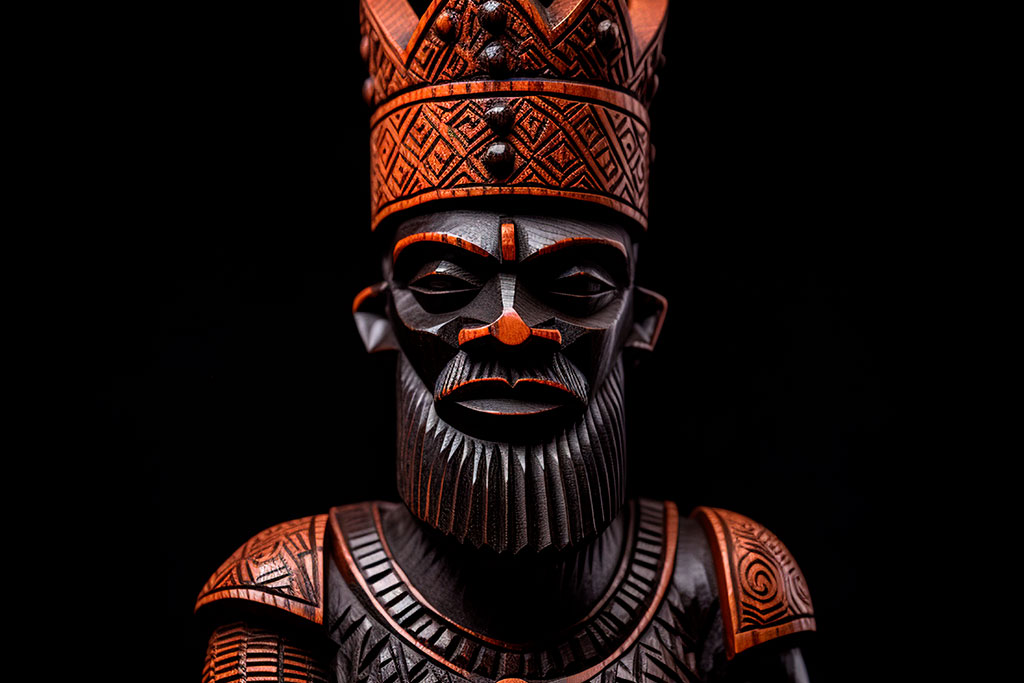
The representation of Shango in Yoruba Land is as diverse as it is significant, reflecting his power, his heritage and his spiritual influence. Temples dedicated to this Orisha are adorned with images that capture his divine essence and the power of him as a god of thunder, fire and lightning.
Visual Representations
At the heart of these sanctuaries, the image of Shango dominates with an imposing presence. She is depicted with a robust male figure, a symbol of strength, virility and attractiveness. Frequently surrounded by figures interpreted as his three wives—Oba, Oshun and Oya—these lesser images complement and underline his central role in the Yoruba pantheon.
A common depiction includes Shango with the head and horns of a ram, wielding the handle of a double-edged axe, his Osee Sango, which not only symbolizes his destructive and protective power but also his authority as a king and divine warrior. This iconography highlights the duality of Shango, as a force of nature and spiritual leader.
Symbolic Elements
Accompanying these representations of Shango are various objects that reinforce his connection with the elements and his divine powers. Maracas or rattles made of güiros (Seeree Sango), an inverted mortar and a large water pot containing metal implements, all narrate the richness of her symbology and her functions as an Orisha. Polished stones and lightning stones are particularly significant, serving as a tangible reminder of her mastery over lightning and fire.
Shango's Earthly Image
The earthly representation of Shango describes him as a dark-skinned, muscular and exceptionally attractive man, exuding powerful masculinity. His physical appearance, bare-chested and wearing mid-leg shorts, underscores his connection to the primordial and his indomitable strength. The crown he wears not only affirms his status as king among the Orishas but also symbolizes his sovereignty over the elements he governs.
This multifaceted image of Shango in his temples and in the devotion of his followers highlights his complexity as a deity: a being of immense power and emotional depth, capable of the greatest fury and the warmest protection. The vision of this Orisha, with the divine attributes of him and the imposing presence of him, inspires respect, devotion and love among those who seek guidance and protection from him.
What is Shango's Odu Isalaye?
Within the Yoruba worldview, each Orisha travels to Earth accompanied by a specific Ifa Odu, who defines their destiny and essence. Shango, the imposing Orisha of thunder and fire, is no exception. His arrival into the world is marked by the Odu Okana Meyi, a sign that reveals profound truths about his character and his mission among mortals.
Since his celestial conception, Shango showed a fearful nature, a surprising facet for someone who would become synonymous with power and courage. Terrified by everyday sounds and omens, Alaafin faced the dilemma of how to go down to earth without living eternally in fear. The solution came through Orunmila, the Orisha of wisdom and divination, who, after performing an osode (divination), discovered the Odu Okana Meyi.
Orunmila, understanding Shango's need to overcome his fears to fulfill his destiny, offered him 101 stones called "Afeke" as a defense tool and symbol of protection. This act not only transformed Chango, igniting a fire of bravery in his heart, but it also solidified his role as the "king of bravery." Since then, obakoso He was feared and respected in both heaven and earth, capable of inspiring terror in those who provoked his wrath, using Afeke to hurl sacred stones at his enemies.
You Might Also: All about the Orisha Elegua, The owner of the roads
Shango Rituals and Traditions within Santería
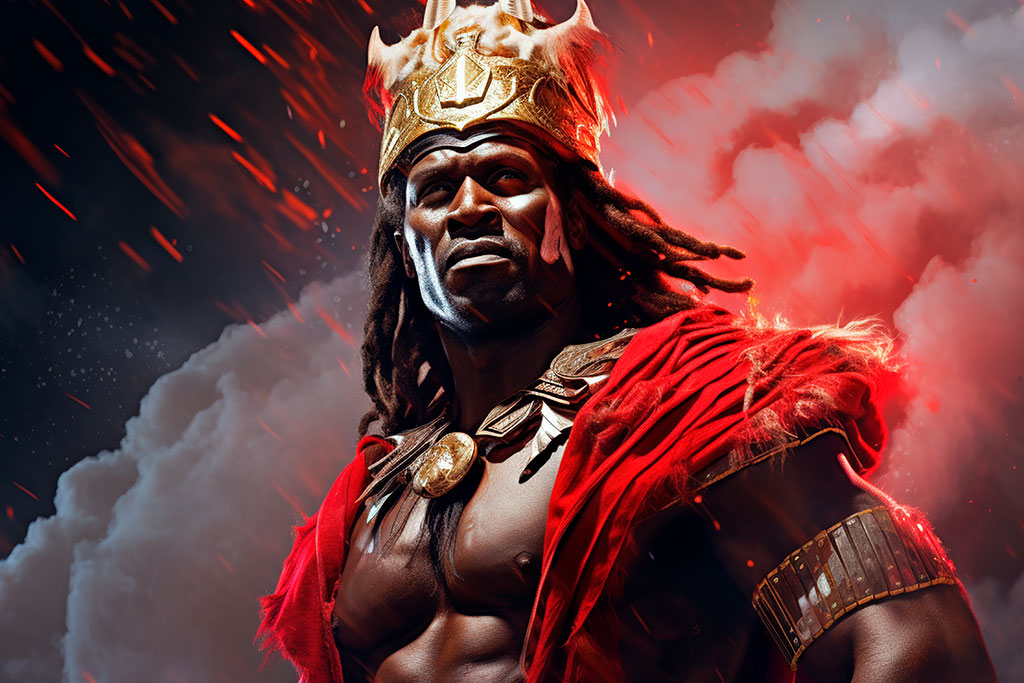
The veneration of Shango in Santería is an essential component of this rich religious tradition, marked by specific rituals, offerings, and a deep spiritual connection with this powerful Orisha. Here we explore the fundamental practices that define the relationship between devotees and the god of fire, revealing how this Orisha influences the lives of his followers.
The Importance of Receiving Shango
Shango occupies an irreplaceable place in the Yoruba pantheon, being essential for those new to Santería. Consecration in Kariosha, or coronation as a saint, includes receiving the foundation of this deity, regardless of the initiate's guardian angel. His protective role and divine hierarchy establish him as a crucial witness to the consecrations, ensuring his blessing and guidance before Olodumare.
How Shango is received
To receive the Orisha Shango, it is carried out during an initiation ceremony that lasts seven days, in which not only the foundation of the God of fire is received, but also that of other Orishas. For those who need to receive it individually, a special three-day ceremony is offered, culminating in the delivery of the secret of Alaafin to the initiate.
What is Shango asked for?
Followers of Shango seek his guidance and protection in a wide range of circumstances. Here are some of the most common requests made to this powerful Orisha:
- Conflict Protection: In both earthly and spiritual challenges, Shango's protection is sought to overcome wars and disputes.
- Assistance in Diseases and Conditions: To relieve afflictions related to burns or any disease, its healing power is used.
- Overcoming Obstacles: You are asked for help to overcome difficulties and barriers in the lives of devotees.
- Success in Negotiations: At times of important agreements and negotiations, Chango is invoked to ensure favorable results.
- Justice and Equity: For those who feel victims of injustice, Alaafin is a crucial ally in the search for justice.
- Prosperity and Development: Your intercession is requested to achieve economic and personal prosperity.
- Search for Love: To attract love or solve problems in love relationships, Shango is entrusted.
- Strength in the face of life's problems: To face and overcome everyday adversities with courage and strength.
- Clarity and Mediumship: Your guidance is sought to gain clarity in decision making and improve psychic or spiritual abilities.
- Success in Difficult Goals: To achieve goals that seem unattainable, your support is asked.
- Mental Health: In cases of depression or suicidal thoughts, the comfort and protection of this deity is sought.
- Mental Clarity and Decision Making: For those moments of indecision or confusion, your light and guidance is requested.
- Planning and Strategy: You are asked for wisdom to plan successful strategies in different areas of life.
Greetings and Reverence to Shango
The salute to Shango, especially when it thunders, is an expression of recognition of his majesty and power. "Kabiosile" or "kabiyesi" are exclamations of respect towards his supremacy, reflecting the deep reverence that is held for him. During ceremonies and rituals, those present show their respect through specific greeting gestures.
Prayer to Chango translated
Je ko ye mi Sango Baale Koso Aremu bale Agboradu
Ogboran mu dun dakun mo and me. Aremu njo or Buru igba ni Bogpe.
Meaning:
Let everyone alert their children, so that “Chango” is not accused of kidnapping.
When he wants to be aggressive
Transform a tree into a man.
When he wants to be aggressive
transform a man into an animal.
You can read: The most powerful prayers to Shango
I sing to Shango
Attentions and Offerings
Offerings to Shango include everything from Amala Ila, a corn flour dish with okra, to specific fruits, drinks and other foods that are pleasant to him. These offerings seek to attract her favor and protection. In addition, specific animals are sacrificed, following rigorous ritual procedures to ensure its effectiveness.
That eats?
Shango receives sacrifices that include everything from rams to jicoteas, roosters and other animals, depending on the specific needs of the ritual and the consent obtained through divination. Specific fruits and herbs are also part of his offerings, each selected for their spiritual meaning and connection to this Orisha.
In specific circumstances, as long as it is registered under an Ifa or diloggun registry, you can eat: goat, turkey, dog, snapper, steers, pigeons, among others; using very special ceremonies for this, which should be officiated only if you have full knowledge about it.
Herbs for Shango Rituals
The selection of herbs in Shango rituals is essential for the consecration of its attributes and the invocation of its presence. Here are some of the most important ones:
- Cedro
- Poplar
- male jagüey
- Royal Palm
- Paradise
- Bledo
- Mahogany
- Sugar cane
- Tortoiseshell vine
- Mamey
- Pinion
- Break saraguey
- Ruda
- Flamboyán
- Almacigo
- Palma de Mallorca
- Ceiba
- Peony
- Hash
- lose direction
- kola leaves
- leaves of ero
- Sandbox
- Atipola
- Cordoban
- red mamey
These herbs are used in different rituals, from the preparation of baths for consecration, to the creation of shelters and offerings, reflecting the rich botanical diversity present in the practice of Santería and its deep connection with nature.
You can read: What are the Children of Shango like?
Shango and Syncretism with Saint Barbara in the Catholic Religion
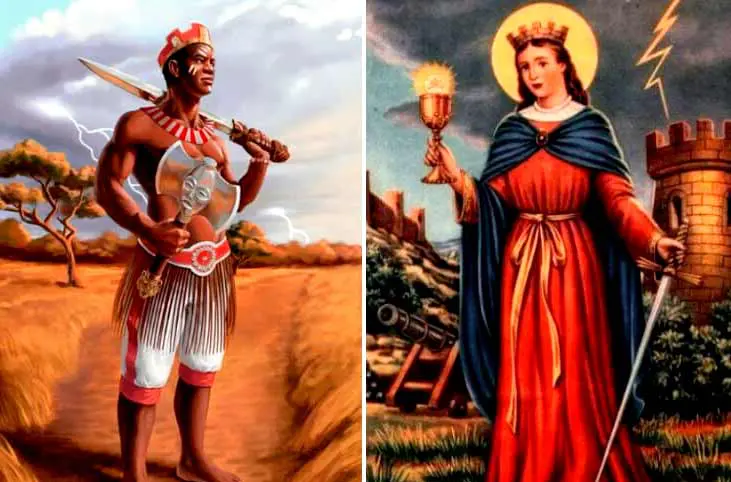
Shango's association with Saint Barbara in religious syncretism is an intriguing phenomenon that combines elements of Yoruba religion and Catholicism. This symbolic union generates curiosity and debate among practitioners and scholars alike, especially considering the masculinity of Shango and the femininity of Santa Barbara. We explore some explanations of this relationship below:
Sharing Attributes
- Common Attributes: Santa Barbara and Shango share symbols of power such as the castle, the sword, and red elements, reflecting similarities in their mastery of protection, lightning, and war.
Interpretations of Syncretism
- The Deity Oshe: One interpretation suggests that the syncretism is not based directly on Shango, but on a minor deity, Oshe, represented on Shango altars with a double-edged axe, similar in serenity and attributes to Saint Barbara.
- Chango's Escape: A legend relates how Chango disguised himself in Oya's clothes to evade Ogun, which some interpret as a reason for his association with a female figure in syncretism.
Reflections on Syncretism
- More than Simple Parallelisms: Syncretism transcends superficial coincidences in attributes, reflecting a deep integration of spiritual practices and cultural survival during the African diaspora.
- Cultural Adaptation and Survival: Shango's assimilation with Saint Barbara illustrates how enslaved Africans preserved their religious beliefs by adapting them to Catholic iconography, thus allowing the practice of their rituals covertly.
Shango's syncretism with Santa Barbara highlights the ability of religious traditions to adapt and merge in contexts of cultural exchange. This amalgam has not only survived over the centuries, but has also enriched faith and religious practice in Latin America.
Patakíes and Stories of Shangó
The stories and patakíes surrounding Shangó, the powerful Orisha of thunder, lightning and justice, are full of moral teachings and divine adventures that reveal his impact in both the spiritual and earthly realms.
Shango's Legacy in the Kingdom of Oyo
Among the stories that make up the heart of Yoruba tradition, the figure of Shango, the god of thunder and lightning, emerges strongly for his heroic deeds and his rule in Oyo, a prominent entity in Yorubaland. The stories that circulate about his life weave a tapestry that illustrates both the divine nature of him and the human side of him, showing his unwavering influence and righteous character.
A notable story of this Orisha tells how, while still a child, he confronted the King of his village, claiming his rightful place as the true ruler. This daring challenge triggers a series of supernatural events and revelations that evidence his divinity and his rightful right to rule.
After being thrown into the river by order of the king to be killed, Chango makes a miraculous return to the palace, surprising everyone with his reappearance, a clear testimony of his immortality and divine power. Later, in an act of cunning and power, he escapes his captors and, through a series of magical transformations, presents himself hanging from a tree, further confusing the residents of the kingdom with his ability to defy the death.
The most shocking moment comes when, after making sacrifices in his honor, The Orisha of Lightning frees himself from the bonds of death and returns to life, proclaiming his innocence and divine status. This act of resurrection not only establishes her superhuman nature but also reaffirms her inalienable right to her throne.
In his final rise to power, Shango sits on the throne not through usurpation or violence, but recognized for his divinity and his rightful right as ruler. His acclamation as "Oba Koso" symbolizes his undisputed sovereignty over Oyo, cementing his place not only in Yoruba history but also in the pantheon of Orishas as the deity of thunder, justice and fire, venerated by those who seek his protection and guide.
Shango crowned Yemaya
In the chronicles of the orishas, the story of Yemaya, the Orisha of the sea, who was going through a period of adversity and challenges. Looking for solutions, he went to Orunmila, the deity of wisdom and destiny, who after consulting Ifá, advised him to be patient and told him to make a sacrifice to change her fortune.
As Yemaya began his return, he met a child who asked him for help with a basket. By helping him, it was revealed that the boy was actually Elegua, the orisha of roads and opportunities, who, through a trick, dirty Yemaya's outfit. Remembering Orunmila's words, Yemaya maintained his composure and continued his journey, without giving in to frustration or discouragement.
His test of faith and perseverance continued when he encountered an old man, another manifestation of Elegua, who again challenged his patience. Despite the setbacks, Yemaya continued forward, not giving in to despair.
Exhausted, Yemaya arrived at the gates of a majestic palace in a beautiful city, where she was initially rejected. However, Yemaya's fortunes were about to change. After falling asleep from exhaustion in front of the palace, she woke up to discover that the doors were open. As she entered, her presence captivated the king, who quickly recognized her divinity and offered her respect and veneration.
The king, revealed as Shango, the powerful Orisha of thunder and justice, knelt before Yemaya, requesting his blessing. In an act of recognition and honor, Alaafin He placed his crown on Yemaya's head, proclaiming her queen of that kingdom. This gesture by Chango not only meant the recognition of Yemaya's power and greatness, but also her promotion to a position of honor and respect among the orishas and her devotees.
Chango's coronation of Yemaya is a story that symbolizes the interconnection and mutual respect between the Orishas, highlighting the importance of perseverance, faith and humility on the path to recognition and spiritual authority.
The First Shango Sanctuary on Earth
The founding of the first sanctuary on earth for Shango, the Orisha of thunder and fire, begins with the story of Ogbe Otrupón, who, before his arrival in the world, was instructed to offer pumpkins as a sacrifice. This act of devotion prophesied the protective role that he would later play against the fury of this powerful Orisha, without knowing that they had inherited a spiritual debt with him.
Upon settling on the land, Ogbe Otrupón planted pumpkin seeds around his home and anointed them with palm oil, thus creating a protective shield against possible divine punishments. The situation changed when the Orisha, adopting human form, appeared looking for the previous offending owner, only to find a family oblivious to the past misdeeds.
After locating and punishing the true offender with a deadly ray, the Orisha thanked Ogbe Otrupón's family for their unintentional help in his revenge, promising not to attack homes marked with pumpkins. His gratitude also manifested itself in blessings, with the birth of a child bearing the symbols of his power: a lightning stone and a double-edged axe. This child, recognized by the Orisha as Oke, was destined to be a distinguished disciple and the first earthly priest in his cult, marking the beginning of the devotion and the construction of the first sanctuary in his honor.
This story not only highlights the power and compassion of the Orisha but also the deep relationship between the Orishas and their followers, demonstrating how acts of faith and divine commitments form the basis of Yoruba religion and spiritual practice in Santeria.
Conclusion
The figure of Shangó, with his impressive mastery over thunder, fire and lightning, is one of the most revered in Santeria and the Yoruba religion. His story, from warrior to deity, illustrates a legacy of power, justice and protection. This Orisha not only symbolizes the strength and courage needed to face life's challenges, but also embodies the importance of wisdom and justice in maintaining balance and harmony.
The traditions and rituals associated with this central figure reinforce the spiritual connection between practitioners and the divine, offering access to his guidance and protection. Through syncretism with Santa Barbara, the adaptability and resilience of these ancestral beliefs is highlighted, keeping alive a rich and spiritual heritage.
In short, this Orisha continues to be a source of inspiration and guidance for those within Santeria and beyond, inviting us to seek justice, act with courage, and live with passion. Its presence in the Yoruba religion and Santeria underscores a commitment to the ethical and spiritual principles that underpin these religious practices, ensuring its place as a powerful and protective entity.
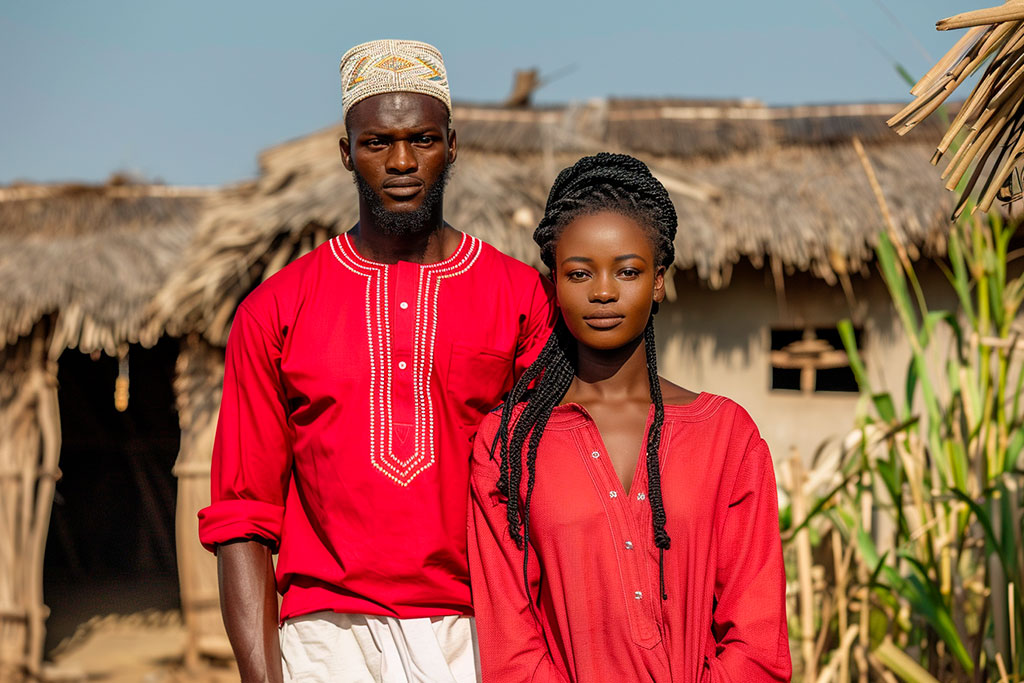
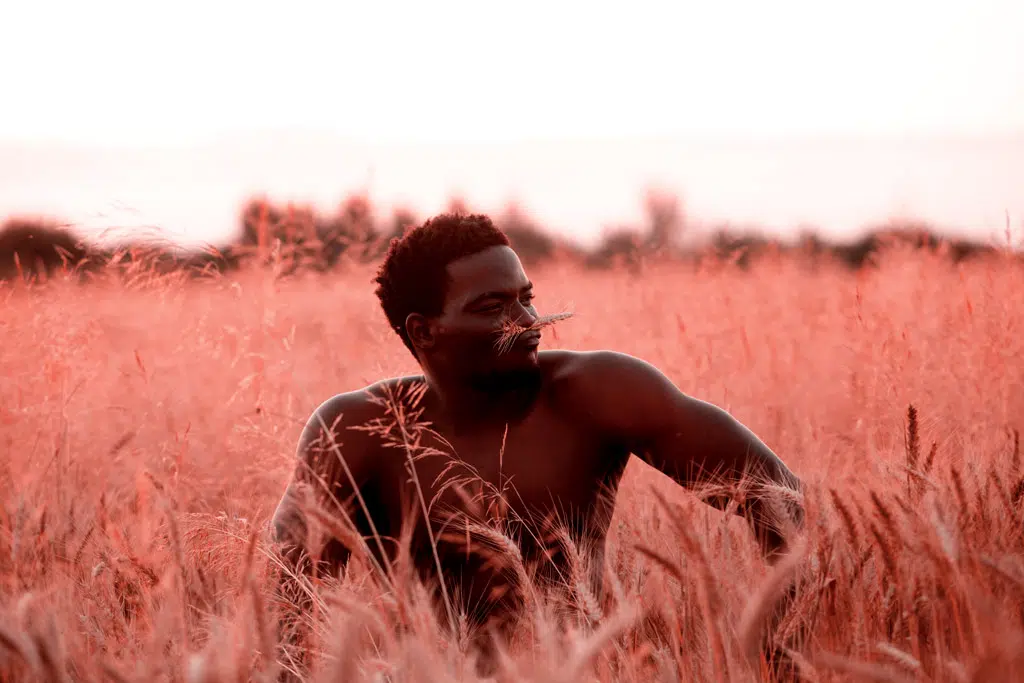
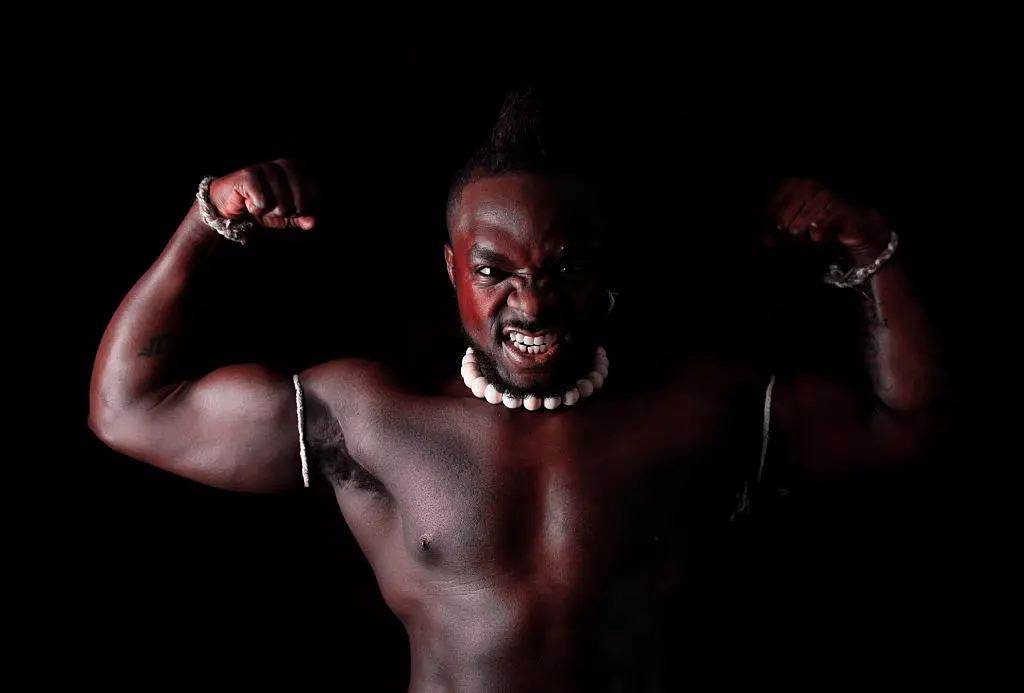
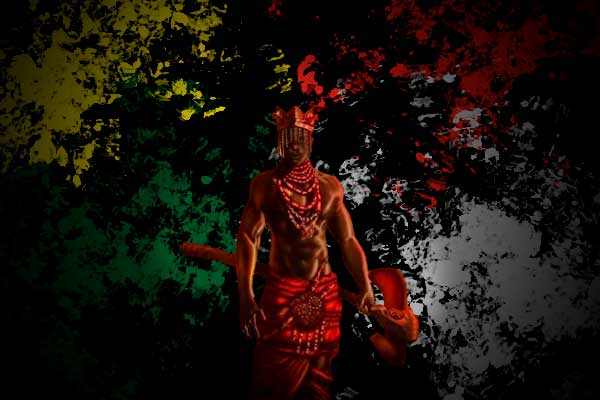
Hello, I like your initiative and the way you present religion.
I am Oni Shango. Maferefún Oba Koso every day of my life.
Cesar Tavera. Oba di melli Ifa loni.
Greetings and blessings. Long life.
Here in Brazil, Sango (written Xangô in Portuguese) is syncretized with Saint Jerome, mainly, but not only. Saint John, Saint Peter and Saint Jude.
The syncretism does not imply in any logjam – Saint Barbara is syncretized with Oyá. And it's all okay!
Best regards from South America.